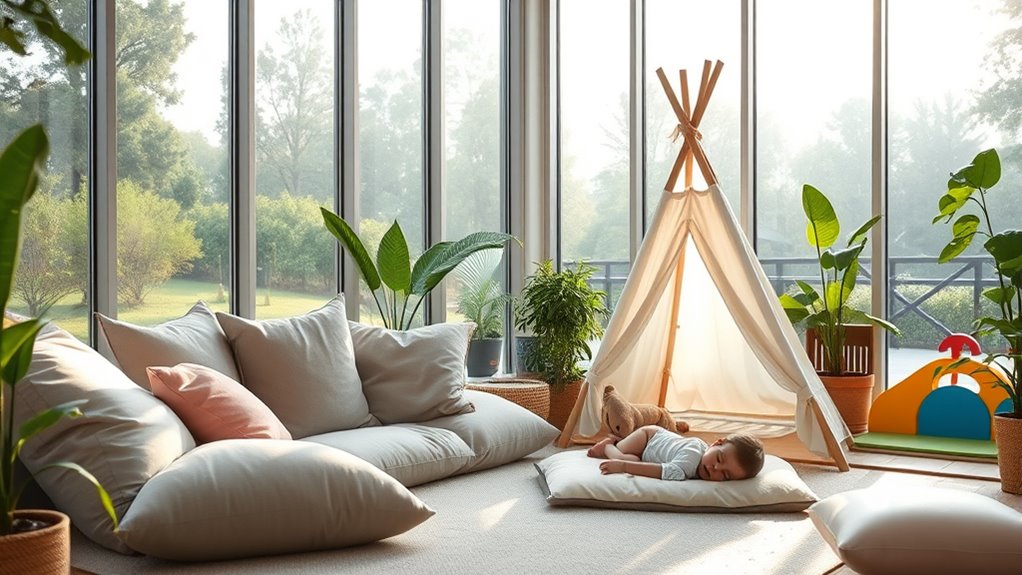To create quiet zones and nap spots in indoor parks, choose calm, sheltered areas away from noise sources like entrances or play zones. Use soundproofing materials, soft flooring, and gentle lighting to make these spaces relaxing. Establish routines and add calming elements like music or white noise. By managing noise and designing comfortable spots, you’ll help toddlers rest peacefully. Want tips on planning these zones effectively? Keep exploring for more helpful ideas.
Key Takeaways
- Designate specific quiet zones with calming decor and minimal noise, clearly marked with signage for easy identification.
- Choose sheltered, comfortable nap spots with soft mats, gentle lighting, and soothing elements like white noise or calming music.
- Manage indoor noise by implementing soundproofing measures, strategic spatial planning, and controlling activity schedules to reduce disruptions.
- Recognize signs of overstimulation in toddlers and guide them to quiet areas using positive reinforcement and routine-based transitions.
- Ensure safety and comfort with unobstructed pathways, secure furniture, and regular safety checks to create a peaceful, toddler-friendly environment.
Understanding the Impact of Noise on Toddler Rest in Indoor Parks
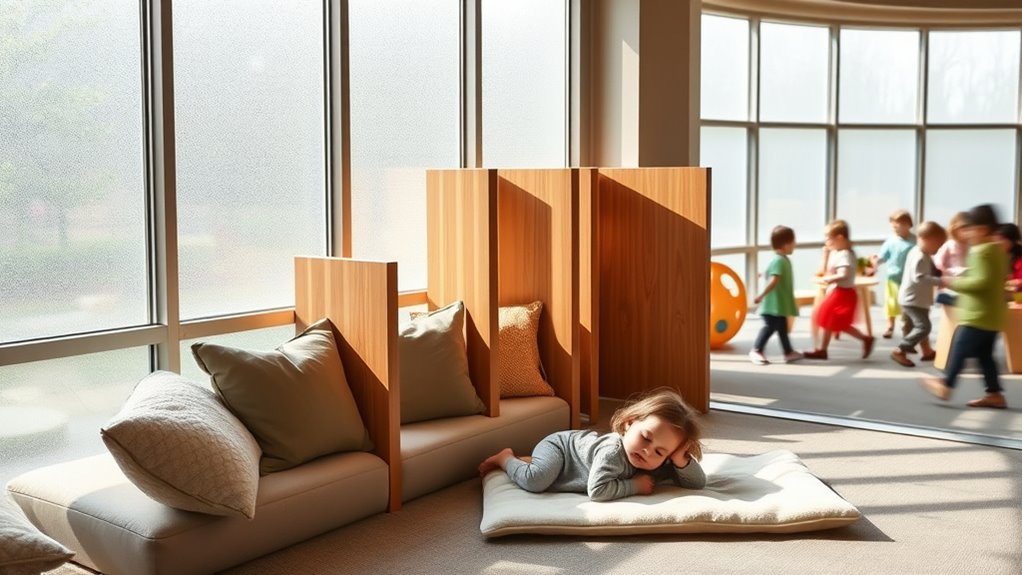
Noise can markedly disrupt a toddler’s rest in indoor parks, making it harder for children to fall asleep and stay asleep. When exposed to loud sounds like play activities, echoes, or background chatter, sleep latency increases. Kids who experience noise are 2.5 times more likely to take over 15 minutes to fall asleep. Frequent interruptions from traffic, construction, or loud electronic devices can fragment sleep, reducing total sleep time by about 52 minutes per night. This disruption leads to more nighttime awakenings and shorter periods of uninterrupted sleep, which can impact a child’s mood, learning, and health. Small ear canals amplify high-frequency sounds, making young children especially vulnerable to noise-related sleep disturbances and long-term health effects. Research indicates that managing noise exposure is essential for healthy toddler rest in indoor environments. Creating a quiet zone within indoor parks can help mitigate these effects and promote better sleep habits for toddlers.
The Role of Greenery and Natural Elements in Creating Calm Environments
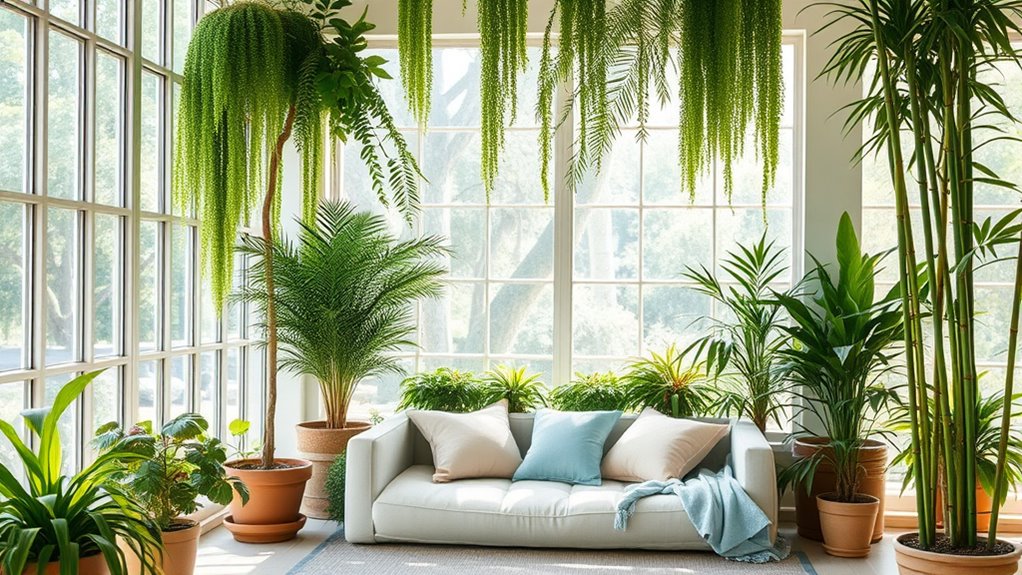
Incorporating greenery and natural elements into indoor parks can considerably promote a sense of calm and relaxation for young children. Exposure to green spaces correlates with fewer early internalizing symptoms like anxiety and depression, especially for children living near parks within three-quarters of a mile. These natural elements help reduce environmental stressors such as noise, heat, and air pollution, creating a more soothing sensory environment. Greenery also supports emotional regulation by providing calming effects rooted in our evolutionary responses. Additionally, natural settings foster social interaction, which benefits cognitive and emotional development. For vulnerable populations, increased access to green spaces offers pronounced mental health benefits. Research shows that exposure to green space during early childhood can lower the risk of neurodevelopmental disorders. Overall, integrating plants, trees, and natural features helps create a restorative, peaceful environment ideal for calming toddlers in indoor parks. Incorporating diverse natural elements can further enhance these calming effects and create a more engaging environment for children.
Designing Effective Nap Areas for Little Visitors
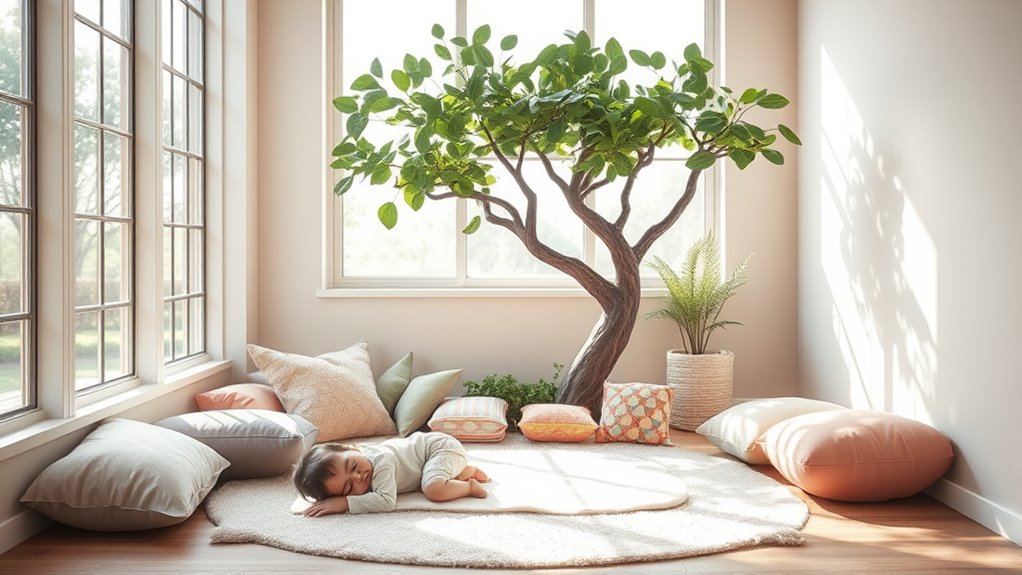
Creating a restful environment for young children requires careful attention to the design of nap areas within indoor parks. You want to guarantee these spaces promote sleep and safety while minimizing disruptions. Start by clearly separating nap zones from active play areas to reduce noise. Incorporate cozy, protected corners or enclosed spaces that give children a sense of security. Allocate enough space—at least 35 sq. ft. per child—to ensure comfort. Keep pathways around the nap spots unobstructed for safe supervision. Use modular partitions to adapt the space as needed, transforming active zones into quiet areas during nap times. Consider soft, cushioned flooring for safety, and control lighting to create a calming atmosphere. Proper zoning and layout planning help create a peaceful environment conducive to rest. Thoughtful design helps little visitors rest peacefully and feel secure in their environment.
Recognizing Behavioral Patterns and Planning for Quiet Zones
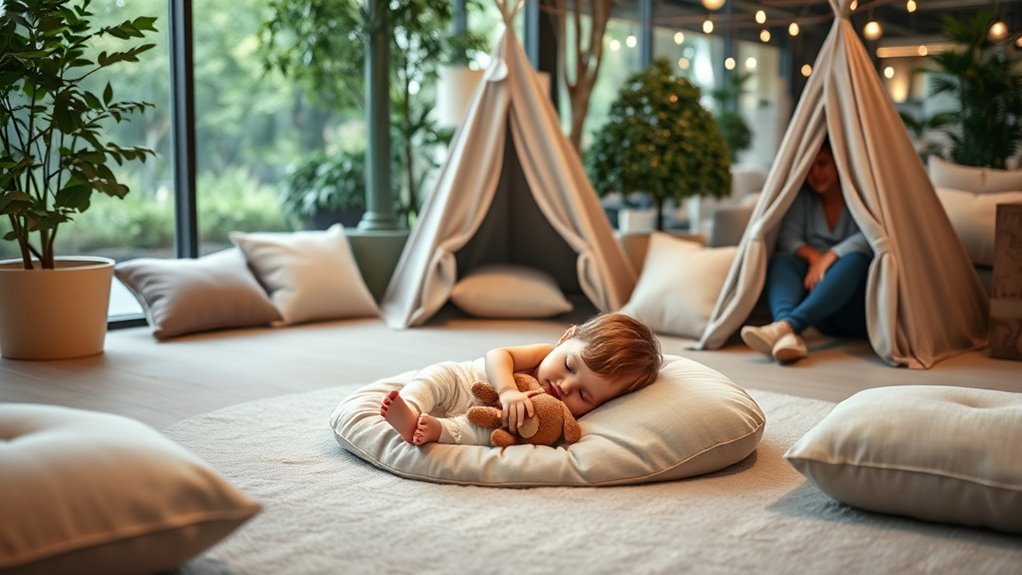
Recognizing behavioral patterns in toddlers is essential for planning effective quiet zones within indoor parks. You should watch for signs like increased vocal volume, fidgeting, or facial expressions of frustration, which indicate overstimulation or discomfort. Understanding that each child’s temperament influences their reactions helps you set realistic expectations and tailor your approach. Before visits, discuss clear, positive behavior rules, and reinforce them through role-playing or simple reminders like “inside voice” or “stay close.” Use quiet zones proactively by guiding toddlers there when signs of distress appear, helping them self-regulate. Providing comforting items and encouraging calming strategies in these spots foster independence and emotional awareness. Proper planning guarantees quieter moments amid the excitement and helps prevent escalation of challenging behaviors. Additionally, children’s brains, especially the frontal lobes, are not fully mature, which impacts their ability to control impulses and manage overstimulation effectively. Being aware of regional resources and tools, such as support systems or local parenting groups, can also offer helpful strategies for managing these behaviors.
Health Benefits of Restful Environments for Young Children
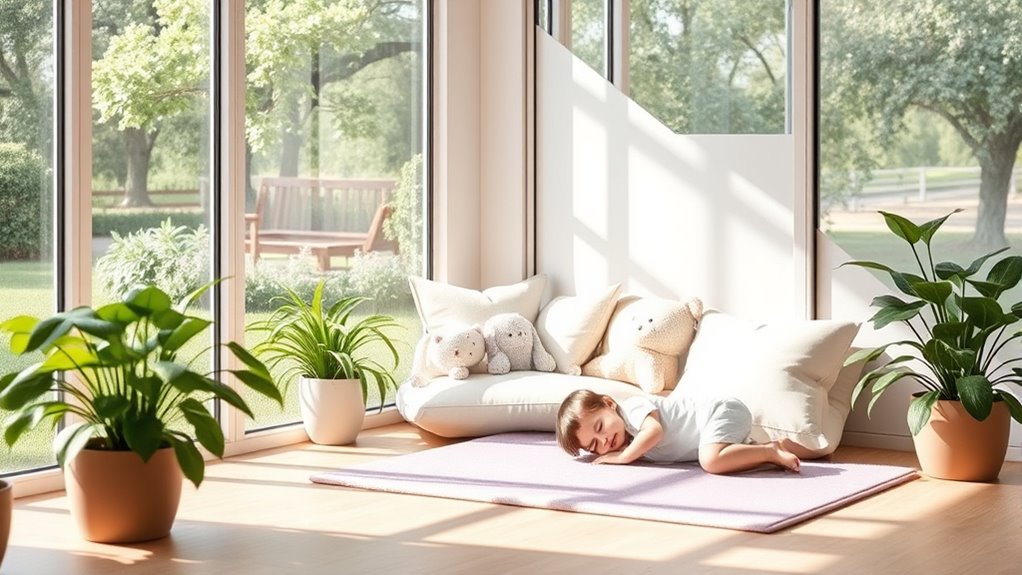
Creating restful environments helps your child’s brain recharge and improves memory, making learning easier. When kids get enough rest, they stay calmer, less stressed, and better able to manage their emotions. Rest is crucial for healthy development in early childhood, and providing calm, quiet areas encourages children to engage in restful activities that promote their overall growth. Additionally, understanding city dynamics can help parents select the best quiet zones and nap spots in indoor parks, ensuring a safe and soothing environment for their children.
Enhanced Cognitive Development
Restful environments play a crucial role in supporting young children’s cognitive development by providing the quiet and comfort necessary for ideal brain growth. When children have a calm space, their brains can strengthen neural connections, improving learning and memory. Quality sleep in peaceful settings helps with problem-solving, critical thinking, and emotional regulation, laying a foundation for academic success. Creating a quiet zone in indoor parks encourages these benefits. Imagine a space where:
- Children rest undisturbed, promoting better memory consolidation
- Soft lighting and minimal noise foster focus and curiosity
- Calm surroundings support emotional resilience and mood stability
- Adequate sleep enhances overall cognitive function and development
- Most infants sleep about 12 hours daily and having a designated quiet area can help establish consistent sleep routines, further supporting brain development. Incorporating restful environments into daily routines can significantly boost a child’s ability to learn, adapt, and thrive, setting the stage for lifelong cognitive growth.
Reduced Stress Levels
Quiet environments not only support cognitive growth but also play a pivotal role in lowering stress levels for young children. When you create calm spaces, children can regulate their emotions more effectively, reducing irritability and anxiety. Restful periods give kids time to process feelings and decompress from overstimulation, which improves their overall mood. Adequate rest is essential for emotional regulation, helping children better manage their reactions to daily stresses. Creating restful environments with minimal noise and disturbance can significantly enhance a child’s ability to relax and feel secure. Consistent routines, including naps and quiet time, act as buffers against family stress, fostering emotional stability. A peaceful setting with minimal distractions helps children feel safe and secure, promoting relaxation. This tranquility supports better social interactions and behavioral control. Additionally, restful environments strengthen resilience, allowing children to recover from daily challenges more easily. By prioritizing calm, quiet zones, you help children develop healthier emotional responses and reduce their stress levels naturally.
Overcoming Challenges in Maintaining Quiet Spaces Indoors
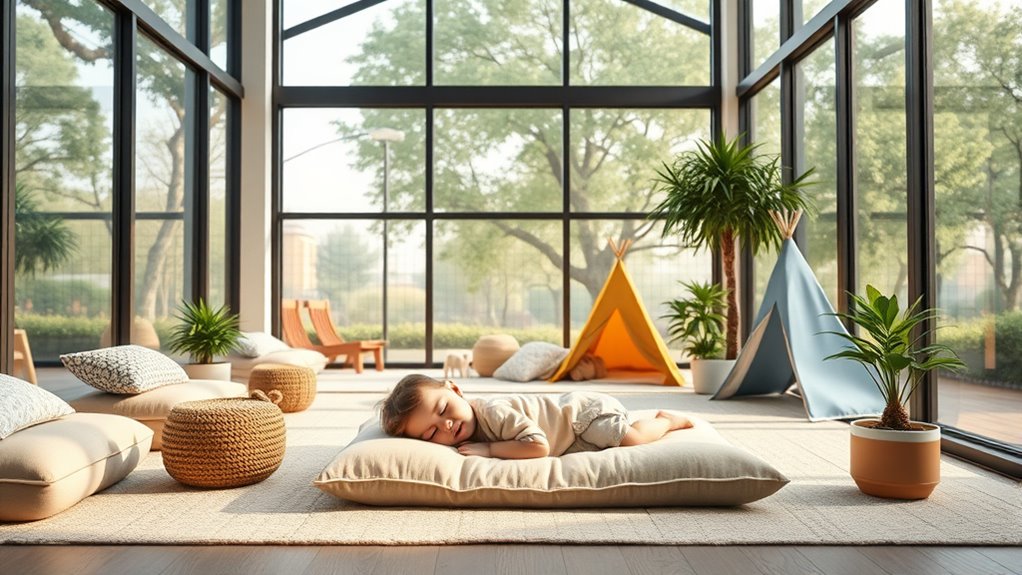
Keeping indoor quiet zones peaceful can be tough when noise sources are unavoidable. Using effective noise management techniques like signage, acoustic monitoring, and physical barriers helps control sound levels. Smart spatial planning, such as locating quiet areas away from busy zones, further guarantees these spaces stay calm and restorative. Implementing soundproofing measures can significantly reduce noise infiltration and ensure tranquility. Increasing human activity indoors makes it essential to implement thoughtful design strategies to maintain tranquility.
Noise Management Techniques
Managing indoor noise levels in quiet zones can be challenging, especially when balancing natural ventilation with sound insulation. You can reduce noise by adjusting window positions—closing them offers the highest attenuation, but tilting or opening them still provides some sound reduction. Material choices matter: massive, inert walls and ceilings dampen airborne sound, while acoustic panels absorb reverberation. Sealing gaps around doors and windows enhances insulation, preventing sound leaks. Behavioral strategies, like scheduling loud activities outside quiet hours or encouraging low-noise play, help maintain a calm environment. Real-time noise monitoring with apps or sensors keeps everyone aware of noise levels, empowering staff and visitors to self-regulate. Incorporating soundproofing materials such as mass-loaded vinyl or specialized insulation can further improve sound insulation. Combining these techniques creates an effective approach to managing indoor noise and preserving peaceful spaces.
Spatial Planning Strategies
Effective spatial planning addresses the challenges of maintaining peaceful indoor environments by thoughtfully dividing areas according to children’s age and developmental needs. Creating distinct zones for infants, young children, and older kids ensures safety and developmental appropriateness. Toddler zones feature low-height, soft foam structures and simple sensory elements to promote exploration while reducing injury risks. Older zones incorporate climbing walls and multi-tiered structures suited for more advanced motor skills. Separating age groups prevents interference, minimizing accidents and overstimulation. Buffer zones between these areas help contain noise and chaos, supporting quiet spaces. Using vertical and modular designs maximizes space efficiency—stacked play structures and reconfigurable equipment adapt to changing needs. Clear pathways and visual barriers facilitate supervision, ensuring quiet zones remain calm and children stay safe. Designing these zones with sound-absorbing materials further enhances the creation of tranquil environments, reducing noise transmission across different areas. Incorporating noise mitigation techniques like acoustic panels or soft furnishings can significantly improve the overall serenity of indoor play spaces.
Implementing Noise-Reducing Strategies and Materials
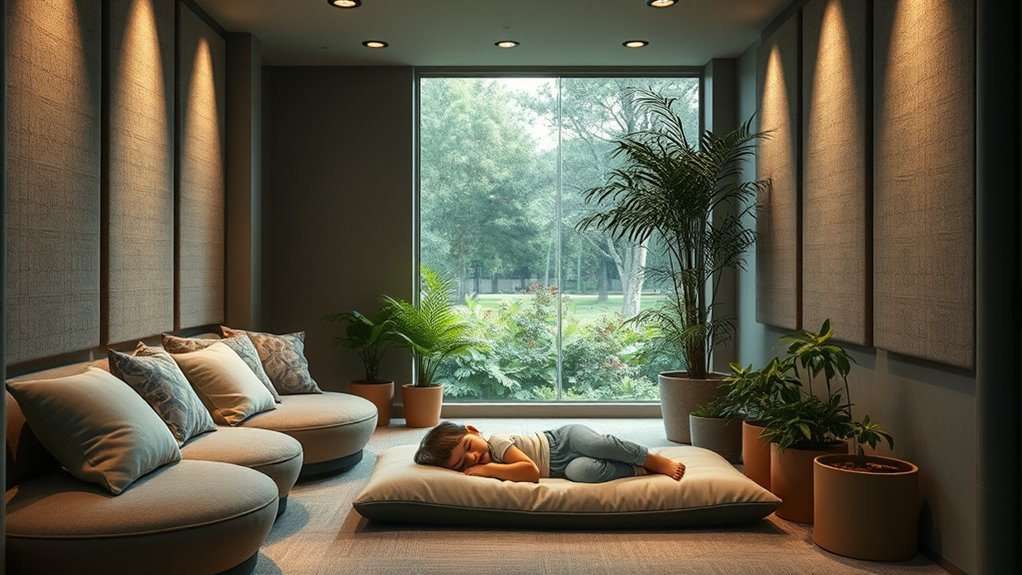
Implementing noise-reducing strategies and materials is essential for creating a peaceful and safe indoor play environment. You can achieve this by incorporating various sound-absorbing elements that dampen noise and echo. For example:
- Thick foam mats with high-impact foam cores, connected with hook and loop tape, absorb impact noise and reduce reverberation.
- Acoustic wall panels made of fabric-wrapped materials soak up sound and control echo, especially when placed strategically along upper walls.
- Ceiling treatments like clouds or baffles trap sound reflections, lowering overall noise levels without obstructing fixtures.
- Upgrading doors and windows with soundproofing mats, acoustic seals, or inserts blocks noise escape, maintaining quiet zones.
- Proper installation of these materials ensures maximum effectiveness, as even the best soundproofing products can underperform if not installed correctly.
- Incorporating sound masking technology can further reduce distracting noises by adding ambient sound that blends into the environment, enhancing overall tranquility.
These materials work together to create a calmer space, making indoor parks more comfortable for toddlers and caregivers alike.
Creating a Balance Between Play and Rest in Indoor Parks
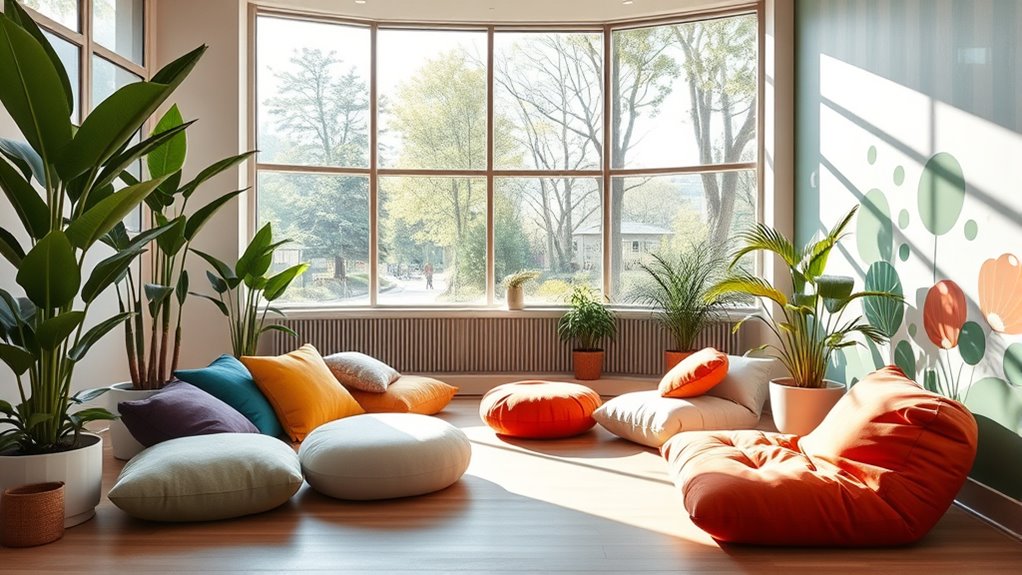
After installing sound-absorbing materials to create a quieter environment, it’s important to contemplate how to balance active play with periods of rest. You should design distinct zones for different activities, including quiet areas where toddlers can relax. Since toddlers need frequent breaks, providing comfortable seating and soft play elements like mats and cushions encourages rest without overstimulation. Here’s a simple guide:
| Play Zone | Rest Zone |
|---|---|
| Active play | Quiet, calming space |
| Visual stimulation | Minimal sensory input |
| Open area | Enclosed, supervised |
| Group activities | Individual relaxation |
Incorporating age-appropriate furniture and play elements further enhances the comfort and safety of the rest zones. Using sound-absorbing materials helps reduce noise levels, making these spaces more peaceful and conducive to rest. This approach creates a harmonious environment that promotes healthy development.
Tips for Parents and Caregivers to Maximize Nap Success
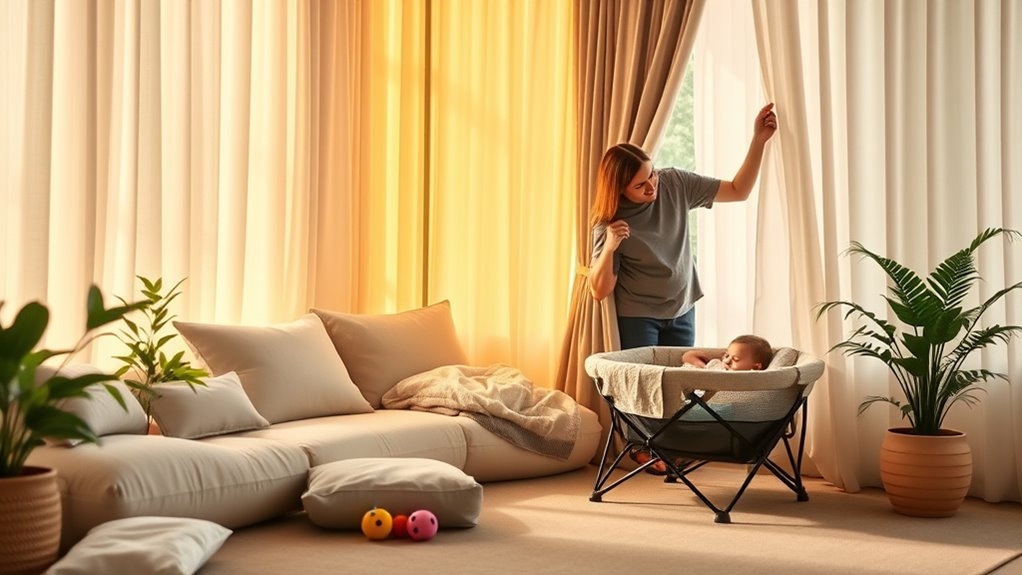
Maximizing nap success for toddlers requires intentional strategies that promote a calm and predictable environment. Establish consistent routines by setting regular wake-up and nap times, which help your child anticipate rest. Before naps, encourage outdoor or active play to help burn energy, then limit stimulating activities like screen time. Creating designated quiet zones with soft lighting, minimal noise, and comfy seating fosters a relaxing space. Use quiet activities such as coloring, reading, or puzzles to keep your toddler engaged without overstimulating them. Limit choices to prevent boredom, rotate toys to keep things fresh, and use timers to signal shifts. Supporting your own needs by resting when possible, planning routines thoughtfully, and seeking community advice can also boost nap success. Incorporating indoor park safety measures ensures a secure environment where your child can enjoy quiet exploration.
Frequently Asked Questions
How Can Indoor Parks Effectively Measure Noise Levels in Quiet Zones?
You can effectively measure noise levels in quiet zones by using sound level meters (SLMs) or data loggers for continuous monitoring. Conduct short-term and long-term measurements, focusing on equivalent continuous sound levels (Leq) to assess overall noise. Exclude irregular noise events to guarantee accuracy. Strategically place sensors away from noisy areas and analyze the data visually to identify patterns, helping you maintain a peaceful environment.
What Are the Best Materials to Soundproof Indoor Nap Areas?
You should select soundproofing solutions that seal, soften, and silence. Dense acoustic panels, like felt or jute-covered wood frames, absorb echoes, while mineral wool or fiberglass insulations block noise transmission. Install solid-core doors and double-glazed windows to seal squeaks and squeals. Seal seams with acoustic sealants, and consider adding mass-loaded vinyl for maximum muffling. These materials tame turmoil, transforming noisy nooks into tranquil, toddler-friendly zones.
How Do Indoor Lighting Conditions Influence Toddler Sleep Quality?
Indoor lighting conditions greatly influence your toddler’s sleep quality. Bright, especially blue, lights suppress melatonin, making it harder for them to fall asleep and stay asleep. Dim, red-toned lighting helps maintain healthy circadian rhythms. Guarantee the room is dark in the evening, use blackout curtains, and avoid screens before bedtime. Proper lighting creates a calming environment, promoting better sleep and overall health for your toddler.
Are There Specific Design Features That Encourage Parents to Use Quiet Zones?
You can encourage parents to use quiet zones by clearly marking them with inviting signage and visual cues that signal calm and restfulness. Incorporate comfortable seating, soothing lighting, and soundproofing features to make these spaces appealing. Strategically place quiet zones away from noisy play areas, and ensure easy access with ramps. When parents see these spaces are designed for relaxation and safety, they’ll be more likely to utilize them for their toddlers.
How Can Indoor Parks Balance Noise From Active Areas With Quiet Zone Needs?
Balancing noise from active areas with quiet zones is like tuning a musical instrument—you want harmony. You should strategically position quiet zones away from loud zones, using soundproof barriers and sound-absorbing materials to dampen noise. Enforce noise regulations, monitor levels regularly, and schedule quiet times. These steps help foster a peaceful environment that encourages parents to use quiet zones and ensures toddlers get the rest they need.
Conclusion
Creating quiet zones and nap spots in indoor parks helps your toddlers rest better, even amid busy, lively environments. While some might say it’s hard to keep these spaces peaceful, thoughtful design and noise-reducing strategies make it possible. With a little planning, you can provide your little one with a calm retreat that promotes health and well-being, proving that restful environments aren’t just a luxury—they’re essential for your child’s development.

